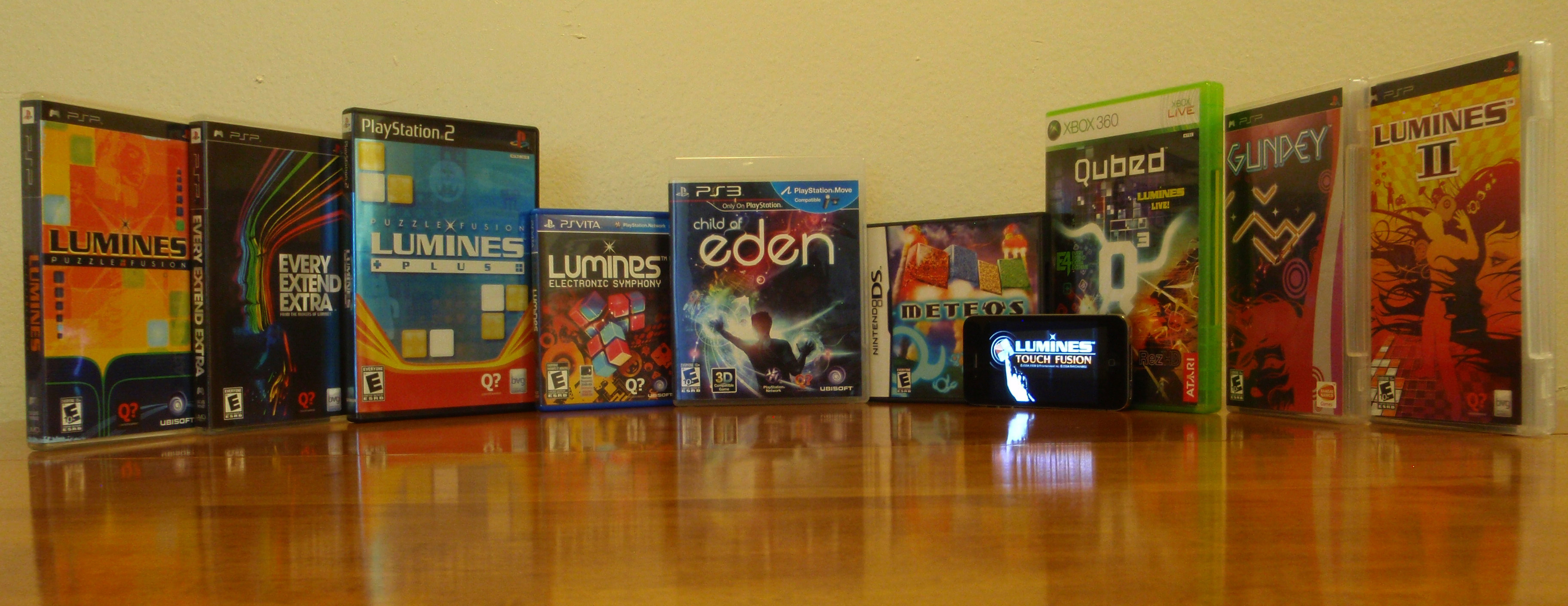
[Note: This is an edited reposting of a write-up I originally posted on another website. Given that text has been added and subtracted in some places, those interested in comparing the content can check out the source text here!)
Up until a few years ago I only played one of Q Entertainment’s games, Lumines. It was the first game I bought for the PSP back in 2005. It was a fun game and I got about 12 skins into it, but I shelved it after a few weeks of play. Years later I would buy another game developed by Q Entertainment -- Every Extend Extra -- as an impulse buy (used game $2.99). Something about that game really clicked with me; kind of like when you would buy an album from a band and you thought it was alright, but would completely love it after not listening to it for a while and then would love the bands whole music catalog. And after playing a few more from their past releases, I now have a tremendous appreciation for Q Entertainment and their style of games. And to show my appreciation, here’s a write up of a few of their games I’ve played and now own.
As a quick backstory, Q Entertainment is an independent Japanese game development studio founded by Tetsuya Mizuguchi in 2003. Before Q, he worked at Sega for about a decade; creating games for both the arcades and for home consoles. Starting with the Sega Rally series, Mizuguchi would eventually lead a new team that was comprised of persons who made games like the Panzer Dragoon series. This would be the team that created games that focused on rhythm and music like Space Channel 5 and Rez. A few years later after Sega merged with Sammy and shifted the corporate culture of the company; Mizuguchi felt it was best that he leave Sega. Shortly after this is when he got to work forming his new indie studio, Q.
Most of Q Entertainment’s games are a fantastic fusion of puzzles and music. And their signature is the backgrounds, or what they call skins, which appear behind the puzzles in which you are trying to solve. Skins can be a static image or they can have some sort of movement when you perform a combo or when the level changes. There are many puzzles that need solving, which means these games have a high replay value and make it worth the price, especially now since most of their games are very inexpensive to purchase when you buy them used. Let’s begin by discussing the first game they have released, Lumines.

Name: Lumines
U.S. Release: 3/22/2005
Platform: PSP
This is Q’s breakout hit and was well received by many critics. The gameplay of Lumines begins by dropping a square with a face that has four smaller squares where they each have one of two colors. At the same time, a vertical line called the “timeline” is moving across the play field. The goal is to line up at least four colors together in a square like pattern. When you line up (or square up) the colors, the timeline will remove those squared colors from off the play field, freeing up space for more blocks. The game ends when you have filled the blocks to the top of the play field. The gameplay is simple, yet addicting. This is the kind of game I like for a handheld gaming console. But the puzzle gameplay is only half of what the game offers.
 Stimulating the senses, the game does a great job on the audio and visual front. Each level consists of a music track where most are of the electronic genre. There is no clock on the screen, so the only way of knowing when you’re progressing in a level is when you hear the music advance to the next looping chunk of the track. It’s very gratifying to hear that part of the song change. It’s like you’re in some sort of trance when trying to match colors, only to be snapped out of it when the sound of the music changes. In addition to audio, each level has its own unique background image. In Lumines these backgrounds are called skins. Most are a static image while some have a bit of animated art in them when something happens during the gameplay. Some skins have abstract images while others have things like space stations or satellite images. The skins keep things fresh so you’re not always looking at one background throughout the entire game.
Stimulating the senses, the game does a great job on the audio and visual front. Each level consists of a music track where most are of the electronic genre. There is no clock on the screen, so the only way of knowing when you’re progressing in a level is when you hear the music advance to the next looping chunk of the track. It’s very gratifying to hear that part of the song change. It’s like you’re in some sort of trance when trying to match colors, only to be snapped out of it when the sound of the music changes. In addition to audio, each level has its own unique background image. In Lumines these backgrounds are called skins. Most are a static image while some have a bit of animated art in them when something happens during the gameplay. Some skins have abstract images while others have things like space stations or satellite images. The skins keep things fresh so you’re not always looking at one background throughout the entire game.
The neat thing about Lumines is that it feels like one continuous game. When you beat a level, the skin and music track changes, but your puzzle pieces remain on the screen. No status screen appears and no interruption in the gameplay occurs. Just keep going with a new track and background.

Name: Meteos
U.S. Release: 6/27/2005
Platform: Nintendo DS
Shortly after the release of Lumines for Sony’s first official handheld console, the PSP, was Meteos; but this time for Nintendo’s latest portable console, the DS. Licensed by Nintendo for the US, Meteos is a quirky little game that oozes with personality. And for a puzzle game, it’s odd to discover that it also includes a story!
The universe is threatened as the sinister planet Meteo has begun launching an assault on all planets! As an offensive tactic, Meteo will rain down a matter known as meteos onto its victim of planets; crushing all life on them. By chance, inhabitants noticed that if three meteos of the same color were to align next to each other, the meteos would fuse together and ignite. This would send them back into space and at planet Meteo.
 As a tile matching puzzle game, but with a twist, it has you matching three of the same color tiles to send a block of them back into space and off of your playfield. Blocks fall from the top and you, the player, use the stylus to move the blocks next to each other to get them to ignite. Each stage is a different planet and each one has a different level of gravity. Some planets with low gravity will have meteos’ flying off quickly with little effort while other planets will have a high gravity level where you’ll need to ignite another set of meteos while in mid-air so there is enough thrust to hurl them into space. Otherwise, they will just float back down onto the playfield.
As a tile matching puzzle game, but with a twist, it has you matching three of the same color tiles to send a block of them back into space and off of your playfield. Blocks fall from the top and you, the player, use the stylus to move the blocks next to each other to get them to ignite. Each stage is a different planet and each one has a different level of gravity. Some planets with low gravity will have meteos’ flying off quickly with little effort while other planets will have a high gravity level where you’ll need to ignite another set of meteos while in mid-air so there is enough thrust to hurl them into space. Otherwise, they will just float back down onto the playfield.
This game can get very hectic as meteos drop down faster and faster. It sometimes gets to the point where you just randomly move tiles quickly to just hoping to score some large collections of meteos’ into space. The value for the game comes by collecting the meteos that you clear from your screen. With them, you can create planets and items. In addition to the story mode where you can pick from three different scenarios, it also includes a ton of other modes to keep things fresh for gameplay experiences.
The charm for the game comes from the fact that each planet has an inhabitant. I believe there are over 30 of them! They usually move along the screen, do a dance, or do some little jig. With this, each planet has a unique looking environment and music. Speaking of which, you can buy the music for each planet and do a basic form of mixing with sound effects. Originally writing this game off, I’m glad I gave it a second look. The biggest joy coming from this game for me is when you are on a heavy gravity planet and sending a large amount of meteos into space at once with the second mid-air ignition. This takes extra effort but pays off well when accomplished.

Name: Every Extend Extra
U.S. Release: 11/7/2006
Platform: PSP
Continuing with their handheld puzzle games is Every Extend Extra. EEE is not an original idea as the game is based on a 2003 freeware game for the PC called Every Extend. Every Extend has only one level, but the goal was to get the better high score. Q built upon the concept by including extra features of gameplay, game modes, and added levels to the game (hence the word “Extra” in the title). And in addition, inserted their own unique style of music and skins to the game; giving it that Q flavor.
You move a ship around and detonate it near enemy ships. When your ship detonates it creates an energy blast. Any enemies caught in the blast are destroyed. Some enemy ships are green and they leave behind a green bonus item. Pick up enough green bonus items and you gain an extra ship to detonate. Other ships are pink and leave behind an item called a quicken. This item increases the speed and frequency of enemies as well as the music for the stage. This creates a more frantic gameplay experience to the game. It’s an advantage to you if you have more quickens because the number of enemies on the screen lead to bigger combos and the ability to collect more items without having to sacrifice more ships. This is a great risk/reward tradeoff.
 There is also a clock counting down to zero. The boss usually appears when the clock has one minute left. The goal is to collect as many ships and quickens before that occurs. Mini bosses in the stage help with this because they leave behind yellow bonus items that add time to your clock. The game is over when you either run out of ships or the clock gets to zero.
There is also a clock counting down to zero. The boss usually appears when the clock has one minute left. The goal is to collect as many ships and quickens before that occurs. Mini bosses in the stage help with this because they leave behind yellow bonus items that add time to your clock. The game is over when you either run out of ships or the clock gets to zero.
The backgrounds are always in motion and create a great visual show while all of the chaos is occurring in the foreground with the gameplay. The music in the game is fantastic and is the best soundtrack when compared to the other games mentioned in this feature. My favorite track is from the Nostalgic Drive level: Summer Party from artist qp. The increased tempo by collecting more quickens really adds to the track, especially when the vocals come in. The frantic gameplay, music, and backgrounds can lead to a sensory overload; which may leave you exhausted when you finish the game or when you lose. Not that that’s a bad thing, but it shows that Q was successful in creating a great shoot ‘em up, which are supposed to be frantic by design.
The game also has a great presentation. Every level starts with a quick intro, displaying the level’s title, the track name and music artist, and a taste of what the visual theme for the level will be. I like how the deeper you get into the menu system, the music keeps adding layers to itself. The original game Every Extend is included too, which allows you to compare the original to the Q version. A unique multiplayer mode is there as well. Every Extend Extra is definitely my favorite game from Q Entertainment’s catalog.

Name: Gunpey
U.S. Release: 11/17/2006
Platform: PSP
Gunpey was released as two different games: one for the PSP and the other for the DS. Both games are different from one another in terms of gameplay and style. I have not played the DS version so this will be about the PSP version.
I don’t think there is a game that I’ve played that could not be more simpler, but have it be so difficult to progress in. All you have to do is connect lines horizontally from left to right across a grid of five columns. All the game pieces will move upward one space every few seconds. The game is over when a game piece crosses above the top of the game field. Whatever line you create will be cleared from the screen, but you have just 2 or 3 seconds to try to add a few more pieces to it to add to your score. The amount of different pieces are a minimal four. Two angled pieces (^ and V) and two diagonal pieces ( / and \ ). The lines can get very large, consisting of crazy zig-zag patterns that go diagonally across the play grid. Things can get out of hand very fast if you don’t manage things well.
 Like Every Extend Extra, this is not an original game created by Q. This is based on a game from the WonderSwan handheld gaming console. And just like in EEE, Q gives the game unique skins and music. There are apparently a total of 40 skins to get. My pathetic self can barely get to the third skin! I’ve been watching videos of people playing the game so that I can better myself and hopefully progress further. It looks like you have to play the game very fast to score huge combos to move quickly across from one skin to the next. I tried that for a bit, but I was just randomly moving pieces very quickly around the screen. Sometimes huge combos would occur and the skin change would be much sooner than my normal and very slow way of playing. This was alright, but it wasn’t fun because I wasn’t really playing the game. Ugh, I guess my brain does not work well with a puzzle game like this one. Give me the visual crazy madness of EEE any day!
Like Every Extend Extra, this is not an original game created by Q. This is based on a game from the WonderSwan handheld gaming console. And just like in EEE, Q gives the game unique skins and music. There are apparently a total of 40 skins to get. My pathetic self can barely get to the third skin! I’ve been watching videos of people playing the game so that I can better myself and hopefully progress further. It looks like you have to play the game very fast to score huge combos to move quickly across from one skin to the next. I tried that for a bit, but I was just randomly moving pieces very quickly around the screen. Sometimes huge combos would occur and the skin change would be much sooner than my normal and very slow way of playing. This was alright, but it wasn’t fun because I wasn’t really playing the game. Ugh, I guess my brain does not work well with a puzzle game like this one. Give me the visual crazy madness of EEE any day!
The presentation in this game is great was well. The menu system does the same thing as EEE where layers are added to the music when you go deeper into the menus. The in-game music is great too. Similar to Lumines, when the skins change the game pieces remain where they are. There is no break in gameplay and you just continue with what you have. Even though this game is difficult for me to move forward in I still enjoy the experience the game delivers in both gameplay and presentation.

Name: Rez HD
U.S. Release: 1/30/2008
Platform: Xbox 360
Rez was originally released for the Dreamcast back in 2001. It was a Japan only release, but in 2002 would be ported to the PlayStation 2 for other regions. Published by Sega and developed by United Game Artists -- a first party development studio for Sega -- it was well received by critics and held by many as a gem. Years later after Tetsuya Mizuguchi left Sega and formed Q Entertainment, he would buy the license for Rez from Sega and re-release the game for modern consoles which now meet the technical requirements he was looking for back at the turn of the millennium when Rez was initially put out on store shelves. Specifically, he wanted Rez to be displayed in wide screen high-definition with high end audio output. Because of this, this re-release would be titled Rez HD.
Not messing with the formula, Mizuguchi decided to not remake the game. Instead, the team at Q would just polish it up for HDTVs. Mizuguchi noted Rez HD would come from the original Dreamcast version, so everything would feel and play the same.
 Different from the all the other games noted above, Rez is not a puzzle game but rather a rail shooter. You control a character and move a reticule around to target enemies. You can target and fire on a number of enemies at once by pressing-and-holding the lock-on button as you sweep the reticule across your foes. When you do, the sound effects of your enemies getting hit would actually be notes for music. Novel for its time, the actions you performed while playing affected the music for the level.
Different from the all the other games noted above, Rez is not a puzzle game but rather a rail shooter. You control a character and move a reticule around to target enemies. You can target and fire on a number of enemies at once by pressing-and-holding the lock-on button as you sweep the reticule across your foes. When you do, the sound effects of your enemies getting hit would actually be notes for music. Novel for its time, the actions you performed while playing affected the music for the level.
With music done by DJs, each area (level) has a track performed by one that is used as the beat. For instance, the music for area 1 was done by Keiichi Sugiyama called “Buggie Running Beeps.” With the soundtrack covering a few genres of electronic music, it’s an incredible collection of songs that are so cool to have in one game. Adding to the music, all of your actions such as aiming, locking-on, firing, and hitting enemies and objects will add to the beat. As you can probably tell, music takes center stage in Rez.
A close second to music would be the visuals. The level designs are a mix of colors, wireframes, videos, and particle effects. Flying through the environments of the levels do a good job of placing you in their abstract worlds; having your character flying through tubes, over many types of terrains, and seeing structures that mimic regions of architectural designs like the ancient Egyptian Pyramids, Mughal architecture like the Taj Mahal, and Aztec temples. Each level has a different theme and is expressed with a different color that pulsates and jumps to the audio. When you combine the visuals with the music, it’s a total trance experience which does an incredible job on your senses.
Tying all of this together is the story. You control a hacker who is traveling through a network known as K-project. You need to investigate what’s wrong with “Eden” and prevent what essentially is the internet from going down. On your way to solving this matter are viruses and firewalls that dart around and prevent you from accomplishing this task. Loved how Q gave something as abstract as the internet with a look and feel so unique and lively that the journey you are taken to is so enjoyable. I didn’t play Rez when it was originally released, but I am glad Mizuguchi decided to release it again and not tweak its gameplay so people new to the game would have the same enjoyable experience that many others did when they played it on the Dreamcast or PS2.

Name: Child of Eden
U.S. Release: 6/14/2011
Platform: Xbox 360
It was inevitable that there would be a sequel to Rez. There had to be! An IP with such a good grasp on synesthesia, I’m guessing someone who has played the original would love to try another experiment on that subject again. Well, with a good idea in mind, Mizuguchi and the team at Q created one. But not a sequel, no sir; this time it’s a prequel.
You find out the beginnings of Eden and the AI behind it. The story stars the character Lumi from Mizuguchi’s music/visual project Genki Rockets. Lumi gets attacked and is trapped by a computer virus. And like before, it’s up to you to go in and save her.
To fill in some backstory, Lumi was the first person born in space onboard the International Space Station. She has never been to Earth, but expresses her feelings through songs and sends them to everyone living there. When she passes on, her memories are preserved in data form known as archives. Scientists would eventually attempt to place here memories into Eden, but that’s when the virus attacks and takes her away.
 Like in Rez, Child of Eden is a rail shooter that has you battling viruses and such things as you try to save Lumi. Shooting your enemies causes musical elements and beats for each of the level’s soundtrack. You’ll be taken on a journey through archives that show the evolution of humanity on Earth. This is a beautiful game that seems to harness the power of the current consoles to create fantastic environments for you to fly through. Not using wireframes like in Rez, it seems to have a focus more on showcasing designs based on neurological and molecular themes.
Like in Rez, Child of Eden is a rail shooter that has you battling viruses and such things as you try to save Lumi. Shooting your enemies causes musical elements and beats for each of the level’s soundtrack. You’ll be taken on a journey through archives that show the evolution of humanity on Earth. This is a beautiful game that seems to harness the power of the current consoles to create fantastic environments for you to fly through. Not using wireframes like in Rez, it seems to have a focus more on showcasing designs based on neurological and molecular themes.
The soundtrack is composed by Genki Rockets. Using them as opposed to DJs was a good choice as Genki Rockets have a more whimsical electronic pop music sound with female vocals that work better at complementing the more rounded visuals that are displayed in Child of Eden. This is a contrast to Rez where the level designs were more pointy and jagged so the harder beats of electronic music felt more at home with that design.
It’s a short game, but the replay value is high. Things move so quickly that you want to go back and see things that you may have missed the first time. The music manipulation when aiming and firing is also more engaging compared to Rez. Complementing the replay value, there are a ton of extras to unlock like adding items to a garden which supplement music elements to it in the menus. At first I didn’t believe Child of Eden would live up to the hype for the game it was building itself on. I figured the gameplay would seem outdated and not work well in today’s world of games. I’m happy to say I was wrong as I enjoyed this game from the start of the intro video to the ending credits.
~
It seems hard for studios to keep up their standards up as time goes on, but Q appears to have managed to uphold that high level of quality from when they began up to recent times. They know their strengths and always push those front-and-center on display and keep their weaknesses in check. Puzzles games are perfect for handhelds and their games in that genre always debut on those platforms while the more ambitious games showing up on the more powerful home consoles.
After mentioning all of these high praises, it is a shame to see Q currently changing directions. With Mizuguchi recently stepping down, the company’s focus for games has shifted from music to other genres like J-RPGs and mobile phone type games. However, those shouldn’t overshadow the creativity and unique style that Q brought to gamers to experience and enjoy throughout the years. They know the single thread that most people have in common and enjoy, which is music, and that appreciation for the medium is something that is shown and celebrated across their catalogue of games and what I believe is the connection that is made when people play their games.
Image credits: Wikipedia, Eurogamer, Meteos Official
Posted on: January 15, 2015

